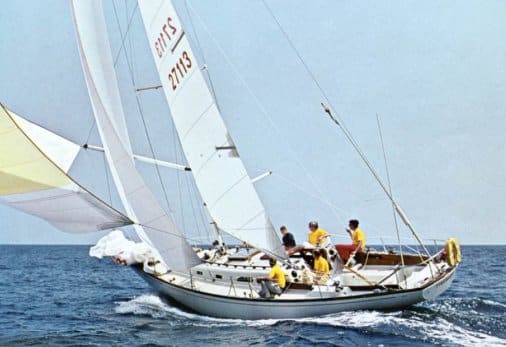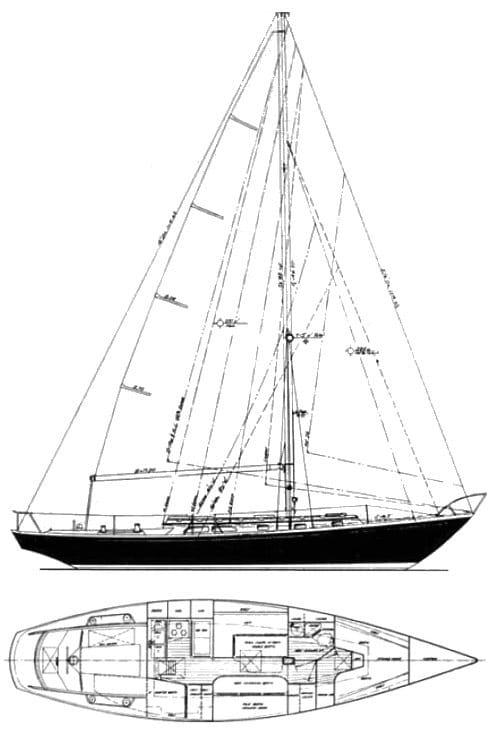
This popular mid-1960s Bruce King design features long ends, low wetted surface, a short waterline and an impressive stability index. The sloop is lean by modern standards, but her easily driven hull shape needn’t be put on its ear to sail efficiently – as did a whole generation of thin-waisted racers and cruisers built to the CCA rule.
The split-molded hull with an integral keel and encapsulated ballast shows good attention to glasswork detail. The thickness of the laminate and the resin/fiber ratio are more than adequate. Most of the deck is a plywood/glass sandwich that has held up quite well. Unfortunately, the coachroof and the bow and stern areas of the deck were balsa cored, and over the years they have tended to suffer from moisture intrusion and rot. I have spent considerable time remedying these problems aboard my 41 Wind Shadow.
The interior joinerwork is anchored to gussets and partial bulkheads that have been bonded securely to the hull, making much of the joinerwork structural and allowing access to the boat’s inside skin. As on many production boats, bulkheads meet the deck in a more or less fashion. By epoxy-bonding lengths of 2-inch x 2-inch mahogany to the underside of the deck and the bulkhead, greater load sharing can be achieved on a refit basis.
The Sparcraft double-spreader rig and external halyards yield poetic simplicity and allow a do-it-yourselfer to maintain the lot with minimum hassle and cost. The rig is a natural candidate for runners opposed by an inner forestay set six feet back from the headstay chainplate and the cutter upgrade.
A tie rod or other stiffening member linking the hull and foredeck should be added if an inner forestay is installed.
Areas to keep a sharp eye on include the mast step, the chain plates and the rudder Ñ Achilles heels for many production-built vessels. Because the problems that arise in these areas involve straightforward fixes, this boat remains a good option in the used-cruiser market.
Under sail the Ericson 41 is pure delight. Her ability in 12 knots or less of breeze is significant, and I have found this relatively benign-sounding attribute to be a huge advantage both inshore and offshore. In a blow she behaves well with two reefs and an inner forestaysail. When things get even worse a storm trysail and storm jib are true value added. In such conditions, the boat’s unique ability to remain under control, even when roller-coastering down the face of steep waves, is most appreciated.

The Westerbeke 4-107 was the auxiliary most commonly installed aboard the E-41. It’s a good, long-lived workhorse at the core, but the Walter V-drive and drive-shaft/prop-shaft combination often need some looking after and careful alignment. The significant downward angle of the prop shaft and the position of the prop itself well forward combine to make the boat a little finicky when backing. Also, assume that the only boats you’ll pass under power will be anchored. Anyone faced with repowering may want to turn the engine around and do away with the V-drive altogether.
Belowdeck, Bruce King shows how a good designer optimizes space and maximizes habitability. It’s not a case of how much the E-41 has in the cabin, rather how efficiently the simple layout works. The U-shaped galley to port and a nav station to starboard lie at the foot of the companionway. The roomy starboard quarter berth, the port settee and the starboard pilot berths are great for seagoing. In port, the forward V-berths and convertible saloon table provide comfortable double berths for guests.
A brokerage E-41 in reasonably sound shape, lightly fitted out with basic sailaway amenity, should tip in between $50,000 and $60,000.
Ericson 41 Specifications
LOA: 41’4″ (12.6 m.)
LWL: LWL 29’2″ (8.9 m.)
Beam: 10’8″ (3.3 m.)
Draft: 5’11” (1.8 m.)
Ballast: 8,200 lbs. (3,720 kgs.)
Disp: 17,800 lbs. (8,075 kgs.)
Sail area: (100%) 715 sq.ft. (66.4 sq.m.)
Mast above water: 54’0″ (16.5 m.)
Ballast/Disp: .46
Disp/Length: 320
SA/Disp: 16.8
Fuel: 55 gal. (208 ltr.)
Water: 85 gal. (322 ltr.)
Holding: 20 gal. (75 ltr.)
Auxiliary: Westerbeke 4-107
Cabin headroom: 6’2″ (1.88 m.)
Designer: Bruce King








